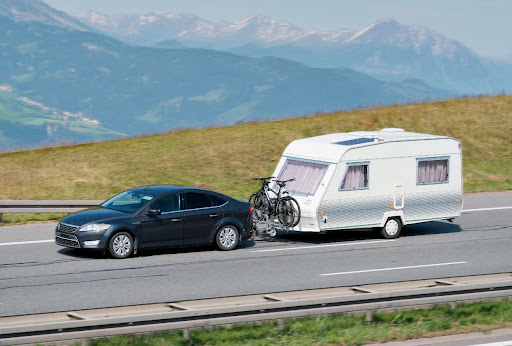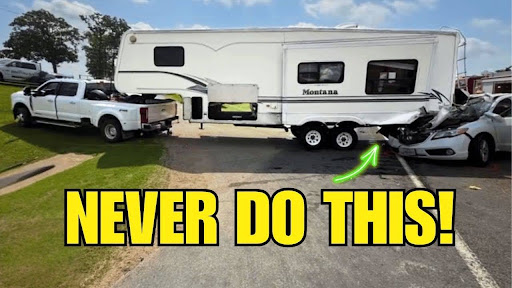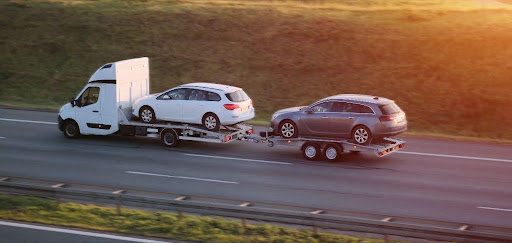Confession time: I once tried triple towing up to Big Bear in a setup so questionable, I’m still amazed the tow gods spared me.
I had the SUV, the camper, and a tiny boat trailer tagging along like a stray puppy. We hit the curves of Highway 18 like a rollercoaster with commitment issues. My husband was silent. The dog looked concerned. I, meanwhile, pretended I knew what I was doing.
Spoiler: I didn’t.
But I learned a lot. If you’re thinking of hauling your whole adventure lineup in one go, here’s the lowdown—straight from someone who’s been there, white knuckles and all.
What Is Triple Towing and Who Can Actually Do It?
Triple towing means you’re pulling three connected vehicles: your tow vehicle, a trailer, and then a second trailer hitched behind the first.
Example: a pickup pulling a fifth-wheel trailer and a boat behind that.
It sounds like a dream setup—until you realize it’s not allowed everywhere.
Is It Legal in California?
Nope. Unless you’re driving a commercial rig or have a specific endorsement, triple towing isn’t allowed in California. That includes any Big Bear-bound adventurers starting in the Golden State.
Other states like Arizona, Utah, and Texas may allow it—each with different rules about total length, safety gear, and weight ratings.
Always check each state’s DOT site before planning your route. One good resource is the RV Safety & Education Foundation, which keeps up-to-date towing laws by state.
Is Your Rig Built for Triple Towing?

Image source: Freepik
Not all trucks—or nerves—can handle it.
Before hitching up a road train, grab your vehicle’s manual and check two things:
- Max towing capacity
- Gross combined weight rating (GCWR)
Your entire setup must stay below this limit, including gear, passengers, and both trailers.
Don’t Guess—Know Your Gear
A fifth-wheel hitch adds more stability than a bumper pull. If you’re adding a second trailer, make sure:
- You have an extended hitch or a tandem tow hitch rated for the job.
- Your trailer brakes are wired to the cab for control.
- You’re using sway control and weight distribution systems.
What Are the Real Risks of Triple Towing?

Image source: Rollin With Rver
Triple towing looks cool—until you’re in a tight campground or sharp mountain curve.
Here’s the tough truth:
1. Turning Is a Circus Act
You’ll need wider turns than you think, and that rear trailer will track differently. Practice in a parking lot before hitting real roads.
2. Stopping Takes Forever
Even with trailer brakes, stopping a triple tow takes longer. Give yourself extra distance—especially downhill.
3. Backtracking? Forget It
Backing up with a triple tow setup is nearly impossible for the average driver. Plan your route with forward motion in mind.
Want to Bring It All? Read This First
If you’re dreaming of hauling your camper and your jet skis, here’s how to do it safely—and legally.
Do a Dry Run
Practice short drives on flat terrain. Pay attention to sway, turns, and braking.
Don’t Overload
Weight matters more than looks. Keep heavier loads in front and double-check your tongue weight.
Stay Visible
Add extended mirrors and rear cams if needed. Triple tows create massive blind spots.
Check Every Hook-Up
Before every trip, inspect your hitch, brake cables, tires, and lights. One loose chain can ruin a vacation.
Can I Triple Tow to Big Bear from Nearby States?
Here’s the catch: even if you start in a state that allows triple towing (like Arizona or Nevada), the minute you cross into California, you’re out of bounds.
That means if you’re planning a mountain getaway to Big Bear, you’ll need to unhook one trailer before the border—or use two vehicles.
Some nearby states where triple towing is allowed:
| State | Triple Towing Legal? | Max Length (Feet) | Notes |
| Arizona | Yes | 65–70 | Needs trailer brakes + safety chains |
| Nevada | Yes | 70 | Requires special endorsement for some setups |
| Utah | Yes | 65–75 | Must maintain full control over brakes |
FAQs About Triple Towing
Can I Triple Tow With a Bumper Pull Trailer?
You can, but it’s not ideal. Bumper pull trailers are less stable and prone to sway. Fifth-wheels are a much safer base for a second trailer.
What’s the Legal Limit for Triple Towing Length?
In most states, the total combined length (vehicle + trailers) must stay under 65–70 feet. That includes your truck, hitch, and both trailers from front to tail.
Do All Trailers Need Brakes?
Yes. Every trailer in a triple towing setup needs its own brake system. Many states require electric brakes with a cab controller, especially if the trailer is over 1,500 lbs.
Are Campgrounds Triple Tow Friendly?
Not always. Many Big Bear and SoCal campgrounds have tight turns or length restrictions. Call ahead or check their website before showing up with your mega rig.
Should You Triple Tow?
If you’re confident in your rig, legal in your state, and have taken time to practice, triple towing can open up a world of adventure.
But if you’re planning to head into California—or Big Bear specifically—it’s a no-go unless you’re a commercial hauler.
My advice? Try it on flat roads in legal states first. Then decide if the extra gear is worth the hassle—or if you’d rather bribe a buddy with a second truck.
Hitch Smart, Not Hard
Triple towing isn’t just about pulling more—it’s about planning better.
If your idea of a perfect trip includes your camper, toys, and a tailgate full of possibilities, triple towing might be your ticket. Just be smart about it. Know the rules. Respect the roads. And maybe don’t try it on a winding mountain pass the first time.














